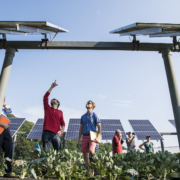The AP Reports on the Benefits of AgriSolar Development
The Associated Press is reporting on the benefits of agrisolar development, that is, the co-location of solar panels on appropriate farm land.
“There’s lots of spaces where solar could be integrated with really innovative uses of land,” said Brendan O’Neill, a University of Michigan environmental scientist who’s monitoring how planting at a new 1,752-panel facility in Cadillac, Michigan, stores carbon.
Elsewhere, solar installations host sheep that reduce need for mowing. And researchers are experimenting with crop growing beneath solar panels, while examining other potential upsides: preventing soil erosion, and conserving and cleansing water.
The Associated Press
As the AP reports, the U.S. Department of Energy is searching for the best agrisolar ideas in a project it has called InSPIRE.
The U.S. has about 2,500 solar operations on the electric grid, most generating one to five megawatts, according to the Energy Information Administration. A five-megawatt facility needs around 40 acres (16 hectares). While some occupy former industrial sites, larger installations often take space once used for row crops.
Depending on how quickly the nation switches to renewable electricity, up to 10 million acres (4 million hectares) could be needed for solar by 2050 — more than the combined area of Massachusetts and New Jersey, an analysis by Argonne found. Solar developers and researchers hope projects with multiple land uses will ease pushback from rural residents who don’t want farmland taken out of production or consider solar panels a blight.
“We need healthy agricultural communities, but we also need renewable energy,” said Jordan Macknick, the renewable energy lab’s lead analyst for InSPIRE.
The Associated Press
Jordan Macknick and others featured in this article including Greg Barron-Gafford, Rob Davis, and Lexie Hain are partners of the AgriSolar Clearinghouse.

 Photo by Dennis Schroeder / NREL
Photo by Dennis Schroeder / NREL Courtesy of Helical Solar
Courtesy of Helical Solar 